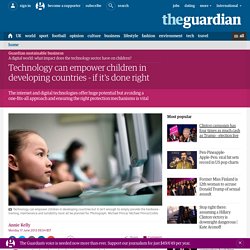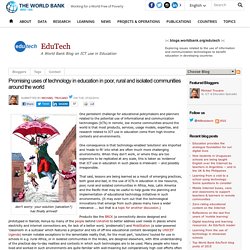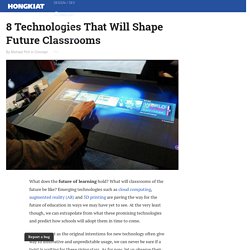

Federal Ministry for Economic Cooperation and Development - Background - The situation in developing countries. Early childhood lays the foundation for the success or otherwise of future learning.

But one in four children under the age of five in the world suffers from malnutrition. These children often suffer developmental disorders, which in turn diminish their chances of a good education. In addition, one half of children of preschool age do not go to kindergarten or similar establishment; in sub-Saharan countries fewer than one in five children have the advantage of early education. Around the world, some 57 million children of primary school age do not attend school. More than half of these children live in sub-Saharan Africa, and more than 20 per cent in South and West Asia. Many boys and girls enrolled in school drop out early. For socially disadvantaged groups access to education is especially difficult. Technology can empower children in developing countries - if it's done right. Over the decade technology has transcended poverty, race and economics to become a driving force in the lives of people across the world.

More than two billion of us now have access to the internet and five billion of us have mobile phones. Children are growing up in a world where social media, mobile technology and online communities are fundamental to the way that they communicate, learn and develop. In recent years the speed, flexibility and affordability of rapidly evolving digital technology has helped slowly prise shut the digital divide between the haves and have-nots and enabled millions of young people in developing countries to join the digital world. Promising uses of technology in education in poor, rural and isolated communities around the world. One persistent challenge for educational policymakers and planners related to the potential use of informational and communication technologies (ICTs) in remote, low income communities around the world is that most products, services, usage models, expertise, and research related to ICT use in education come from high-income contexts and environments.

One consequence is that technology-enabled 'solutions' are imported and 'made to fit' into what are often much more challenging environments. When they don't work, or where they are too expensive to be replicated at any scale, this is taken as 'evidence' that ICT use in education in such places is irrelevant -- and possibly irresponsible. Some principles or approaches to consider when planning to introduce ICTs into remote, low-income educational environments might include: 1. The best technology is the one you already have, know how to use, and can afford (in most cases, this is increasingly the mobile phone) 2. 8 Technologies That Will Shape Future Classrooms.
What does the future of learning hold?

What will classrooms of the future be like? Emerging technologies such as cloud computing, augmented reality (AR) and 3D printing are paving the way for the future of education in ways we may have yet to see. At the very least though, we can extrapolate from what these promising technologies and predict how schools will adopt them in time to come.
However, just as the original intentions for new technology often give way to innovative and unpredictable usage, we can never be sure if a twist is waiting for these rising stars. As for now, let us observe their progress and speculate on how these 8 up-and-coming technologies could potentially change education for the better. Recommended Reading: Major Tech In Education Trends In 2013 [Infographic] 1. We’re still waiting for Augmented Reality to take the world by storm by way of Google Glass, gaming and awesome apps for astronomy. Read Also: 5 Top Augmented Reality Apps For Education A New Way To Teach 3. Welcome to World Series of Innovation. 3 Ways The Internet Of Things Will Change Every Business. Have you entered the Internet of Things yet?

If you have a FitBit or other activity tracker that talks to your smartphone, you have. If you have a thermostat, alarm system, or lights in your home that you can control with your computer or phone, you have. But even if you haven’t got one of those devices yet, I’m betting you will within the next 3–5 years. And I’m not making that prediction based on how useful or cool the current Internet of Things products are right now, but rather based on the fact that I believe the Internet of Things is going to change business at a fundamental level. I believe there are three key ways in which the Internet of Things will change every business: 1. It used to be that we only expected our phones to be able to make phone calls. The line of Fitbit Internet-enabled products (Photo by Eric Thayer/Getty Images) 2.
A big part of the Internet of Things isn’t so much about smart devices, but about sensors. 3. Take John Deere DE +0.23%, for example.